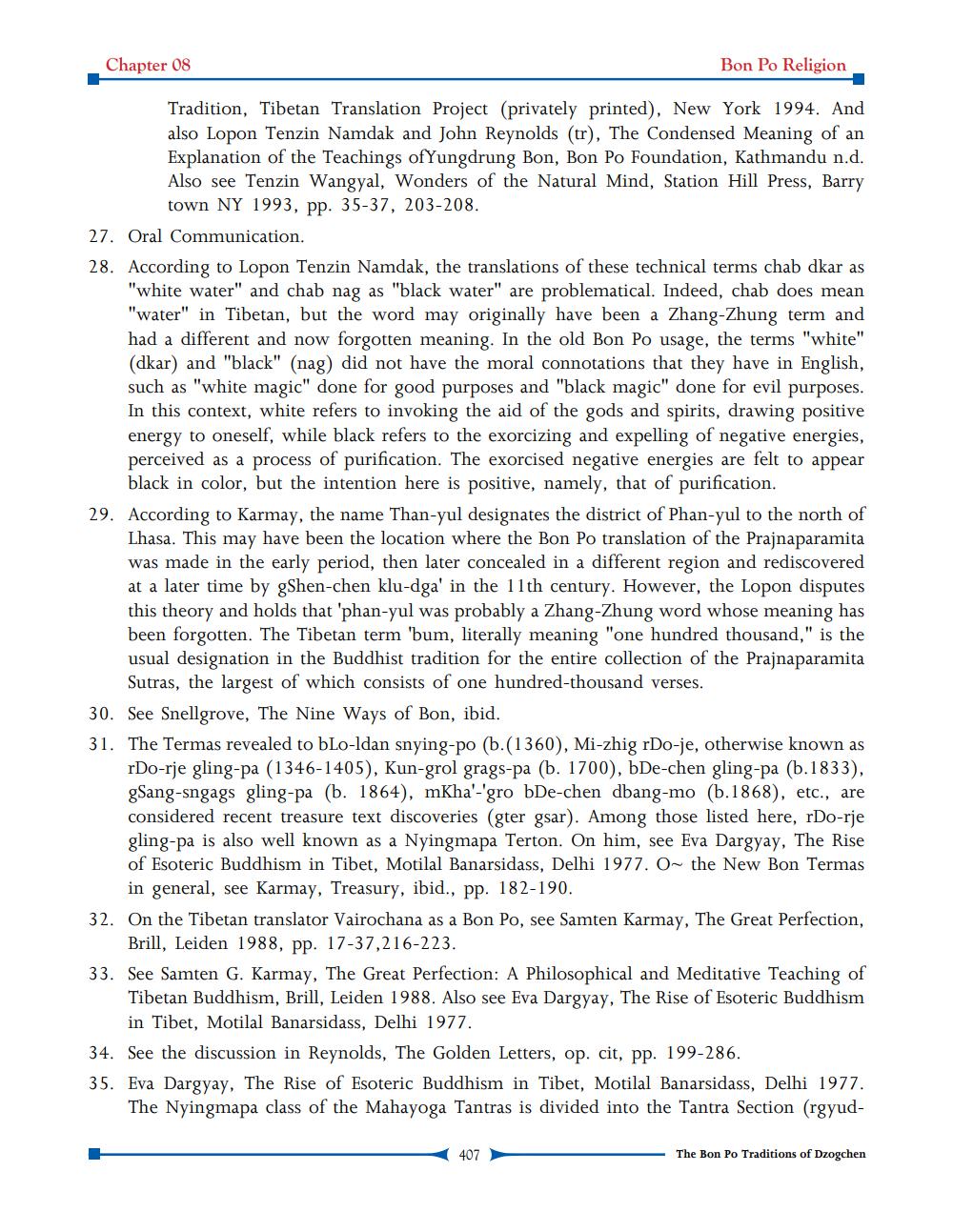________________
Chapter 08
Bon Po Religion
Tradition, Tibetan Translation Project (privately printed), New York 1994. And also Lopon Tenzin Namdak and John Reynolds (tr), The Condensed Meaning of an Explanation of the Teachings of Yungdrung Bon, Bon Po Foundation, Kathmandu n.d. Also see Tenzin Wangyal, Wonders of the Natural Mind, Station Hill Press, Barry
town NY 1993, pp. 35-37, 203-208. 27. Oral Communication 28. According to Lopon Tenzin Namdak, the translations of these technical terms chab dkar as
"white water" and chab nag as "black water" are problematical. Indeed, chab does mean "water" in Tibetan, but the word may originally have been a Zhang-Zhung term and had a different and now forgotten meaning. In the old Bon Po usage, the terms "white" (dkar) and "black" (nag) did not have the moral connotations that they have in English, such as "white magic" done for good purposes and "black magic" done for evil purposes. In this context, white refers to invoking the aid of the gods and spirits, drawing positive energy to oneself, while black refers to the exorcizing and expelling of negative energies, perceived as a process of purification. The exorcised negative energies are felt to appear
black in color, but the intention here is positive, namely, that of purification. 29. According to Karmay, the name Than-yul designates the district of Phan-yul to the north of
Lhasa. This may have been the location where the Bon Po translation of the Prajnaparamita was made in the early period, then later concealed in a different region and rediscovered at a later time by gShen-chen klu-dga' in the 11th century. However, the Lopon disputes this theory and holds that 'phan-yul was probably a Zhang-Zhung word whose meaning has been forgotten. The Tibetan term 'bum, literally meaning "one hundred thousand," is the usual designation in the Buddhist tradition for the entire collection of the Prajnaparamita
Sutras, the largest of which consists of one hundred-thousand verses. 30. See Snellgrove, The Nine Ways of Bon, ibid. 31. The Termas revealed to blo-ldan snying-po (b.(1360), Mi-zhig rDo-je, otherwise known as
rDo-rje gling-pa (1346-1405), Kun-grol grags-pa (b. 1700), bDe-chen gling-pa (b.1833), gSang-sngags gling-pa (b. 1864), mKha'-'gro bDe-chen dbang-mo (b.1868), etc., are considered recent treasure text discoveries (gter gsar). Among those listed here, rDo-rje gling-pa is also well known as a Nyingmapa Terton. On him, see Eva Dargyay, The Rise of Esoteric Buddhism in Tibet, Motilal Banarsidass, Delhi 1977. 0- the New Bon Termas
in general, see Karmay, Treasury, ibid., pp. 182-190. 32. On the Tibetan translator Vairochana as a Bon Po, see Samten Karmay, The Great Perfection,
Brill, Leiden 1988, pp. 17-37,216-223. 33. See Samten G. Karmay, The Great Perfection: A Philosophical and Meditative Teaching of
Tibetan Buddhism, Brill, Leiden 1988. Also see Eva Dargyay, The Rise of Esoteric Buddhism
in Tibet, Motilal Banarsidass, Delhi 1977. 34. See the discussion in Reynolds, The Golden Letters, op. cit, pp. 199-286. 35. Eva Dargyay, The Rise of Esoteric Buddhism in Tibet, Motilal Banarsidass, Delhi 1977.
The Nyingmapa class of the Mahayoga Tantras is divided into the Tantra Section (rgyud
(407
The Bon Po Traditions of Dzogchen




